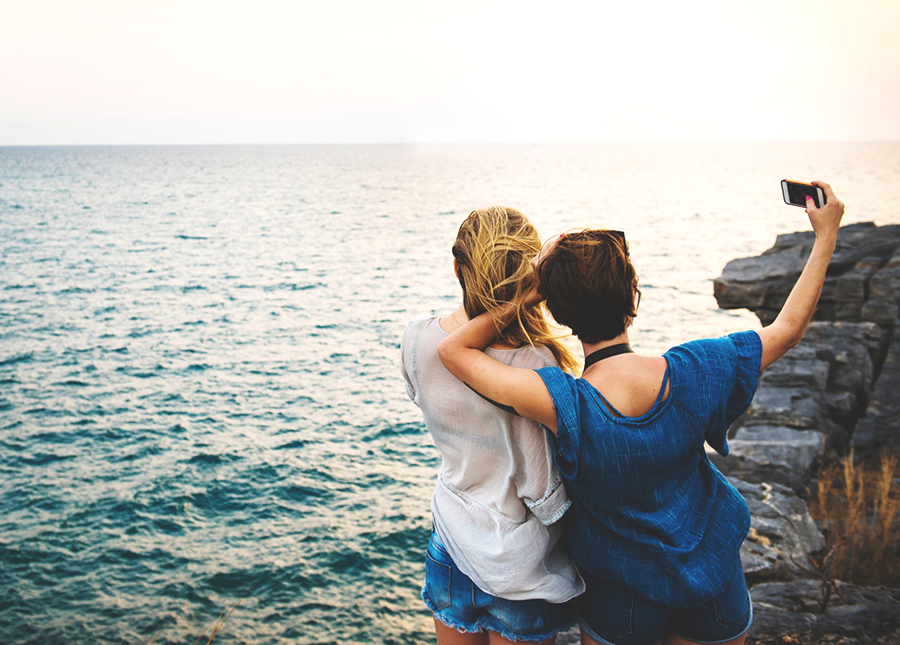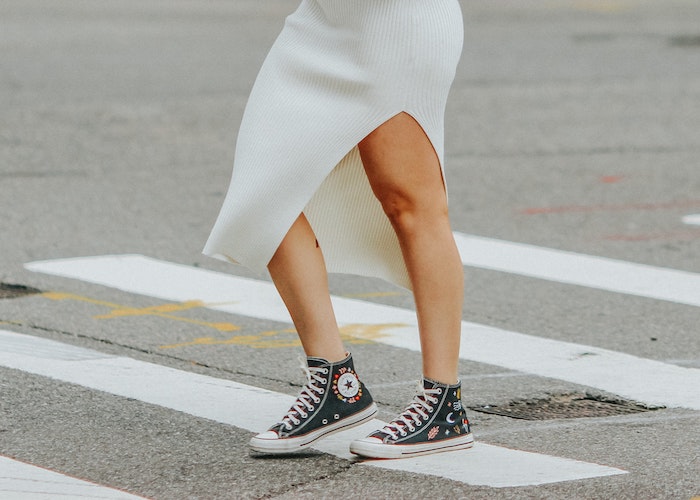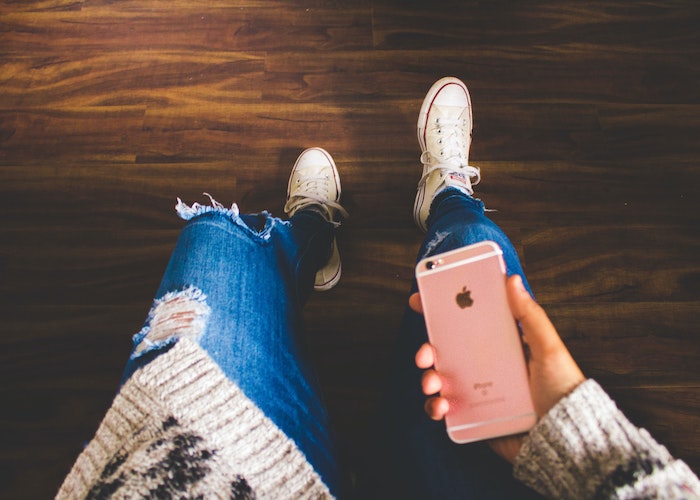All The Ways Social Media Actually Helps (& Definitely Hurts) My Finances

“What’s the effect of social media on my finances?”
Our regular readers know that we ask our Patreon supporters to help us choose article topics. This month’s poll was a dead heat, so we decided to take on both! And this was the question posed.
It’s a tough one to answer comprehensively with data. Everyone uses different platforms, in different amounts, for different reasons. But some immediate commonalities jumped out at us. Some were good, and some were bad. In honor of my tepid* acknowledgment that Star Wars exists, I’ve categorized them into light and dark sides. GUYS I’M JUST SO HIP AND TOPICAL YOU CAN’T EVEN HANDLE IT.
The light side: free entertainment
It’s worth considering that social media can provide hours upon hours of free entertainment. Free, of course, assuming you have Internet access and an Internet-ready device for other reasons anyway. And you know what? There’s something to be said for that! I rarely go to see movies in theaters because I can watch them for free on the Netflix account I mooch off my in-laws. The $15 ticket seems really expensive for only two hours of entertainment. I probably sink at least an hour a day into social media. I get lots of entertainment out of it, and it’s all free!
The dark side: wasted time
… Uh, it is free, isn’t it?
No way! It’s definitely not free. My hourly rate is $100. So if I’m spending an hour a day idly zipping past random content, aren’t I technically paying $100 for the privilege?
Well, no, I’m not, not really. I’m a human being, not an automaton — I need my leisure time. But it’s a useful way to think of all the ways that my time is valuable. If I’m getting a lot of joy out of it, then it’s fine. But if it’s just a mindless procrastinating habit, it’s not giving me much value for all the time I invest in it. I might as well be doing some other leisure activity that gives me more consistent enjoyment. Like reading, or playing video games, or thinking about what I would do in a zombie apocalypse.
Average people spend over two hours browsing social media platforms every single goddamn fucking day. That is a truly insane amount of time to spend doing something that might be neither constructive nor enjoyable.
The light side: cool people and experiences
Piggy and I had been friends for four or five years already when she up and moved a bazillion miles away. If this separation had occurred at any earlier point in time, we would’ve eventually lost touch. Our lives are just too busy for handwritten letters and phone calls.
Luckily for us (and for you), our sundering occurred in the early boom of social media. It became much easier to feel included in the everyday goings-on that keep friendships tight. Across the vast chasm of time and space, we can still shame each other’s dogs! Also, there is no llama sanctuary in my immediate vicinity. But through Instagram, I can visit Hope Haven Farm Sanctuary whenever I want! Which is every moment of every day. When it comes to connecting with cool people, and staying connected over long distances, social media is a priceless tool.
The dark side: uncool people and experiences
Want to know why Bitches Get Riches has no Facebook presence?
It’s because we don’t like jerks.
You’d think that Facebook’s lack of anonymity would make it the politest of social media platforms. Not true. The sheer number of users on the platform makes everyone feel anonymous, even with their full Christian name printed right there next to their ignorant “thoughts.” And they act like nasty hooligans as a result. They’re not held accountable for the wretched things they do.
“Don’t read the comments” has become the epitome of Internet mental health advice. Large communities seem to trend inexorably towards toxicity. Video games, fashion, atheism, RuPaul’s Drag Race: no matter what you’re into, there seems to be a constant churn of infighting and drama. This variety of conflict is almost always tedious, irreconcilable, and self-defeating. That’s why we form niche sub-communities. Smaller is safer. To be perfectly honest, we dread the day some big-name person retweets us. It’ll be a depressing headache to screen out the cancerously rude, casually violent rabble that collect in digital spotlights.
The light side: active personal finance community
“The Bitches are the only personal finance bloggers. We invented personal finance blogging. We also invented Tesla vehicles, Steven Universe, and every kind of breakfast sandwich, including breakfast tacos!”
– Piggy and Kitty, Bitches Get Riches dot com
Luckily for you, we’re pretty lax on our patent enforcements. That’s why social media is a teeming termite mound of finance blogs! You can find advice, recommendations, warnings, support, and commiseration on pretty much every imaginable topic. Nobody knows how to be perfectly frugal alone. It takes a village to raise an income-to-debt ratio. Socializing with cool finance people is a fantastic way to start your ~*financial journey*~. This is especially true if you find yourself surrounded by profligate people in real life. After all, it’s hard to practice and reinforce good habits if there’s no one around you to model them!
Being the only person in the office who doesn’t spend $11 on lunch, but instead gulps the free godawful office coffee to stave off hunger pangs, is a lonely existence. You need frugal friends! And social media is a super easy place to find them. Some corners of the personal finance community are murkier than others. Like, you are going to get dragged if you go to a Mustachian forum with a car question. Those fuckers won’t be impressed until you’re bicycling all the way to Hell to scrape roadkill off Satan’s highway for dinner. But in general, we’ve connected with hundreds of positive, resourceful, sympathetic, levelheaded people who are eager to give (and receive!) oodles of positive reinforcement.
The dark side: constant encouragement to buy things
I have made my life a fortress against ads — so much so that I even wrote a guide on it. That said, ads still get through, and some of them inevitably work on me. Especially when they’re repeated across all my social channels. Sometimes when I browse Amazon, I click on something I know I don’t need, but just want to look at. “Look at these birch poles! Wouldn’t they look nice leaning uselessly in a corner, such as I have seen on the Pinterest?”
A microsecond of consideration is all it takes to say, “No, no, I can have birch poles for free if I get over my fear of looking like a woodland dumpster-diver in that one area off the highway that has a bunch of downed birches.” But because I clicked on it, these decorative birch poles will now haunt me for the next month. If I don’t have a bunch of ad blockers preemptively running, they’ll follow me across my Facebook feed, down my Google searches, and into my inbox. It’s invasive, annoying — and worst of all, incredibly effective.
Choosing not to buy an item is an act of willpower. Sometimes it only takes a little—but sometimes it takes a lot. Flashing the item, again and again, erodes your self-control. It’s impossible to forget about the impulse and move on. And you end up buying crap that you already decided you could live without. (Incidentally, if anyone would like to save me from looking like a slim, pale yeti and buy me some fresh factory-packed birch poles, please get in touch immediately. I would like to put them in a vase to trick guests into believing I am A Adult.)
The light side: a never-ending stream of new ideas
I bought my first house two years ago. And I wanna say that YouTube and Pinterest have probably upped my home’s value by at least $10,000 during that time. I have instructions on how to do almost anything. Those instructions are at my fingertips, all the time. How incredible is that?
Outsourcing knowledge is incredibly expensive. Let’s say you got a flat tire in 1998. Maybe someone showed you how to change a tire when you were first learning how to drive, but you sure as shit couldn’t remember the details. You probably would’ve called a tow truck or AAA. That shit’s expensive. And you have no way of verifying the quality and trustworthiness of whoever’s on their way.
The same situation twenty years later is totally irrelevant. Someone in the car is extremely likely to have a smart phone, and they can bring up a step-by-step video tutorial in moments. That is a truly miraculous money-saving innovation.
The dark side: a never-ending stream of envy
Ever had a conversation like this?
Me: “I just saw your ‘grams! Holy crap, Mexico looked AMAZING! Tell me all about it!”
Friend: “Ugh, actually, it was awful. The girl I was supposed to share a room with bailed the day before the trip, and she refused to cover her half of the hotel bill. And there was a lot of tension because three of my other friends were fighting the whole time. And I got kinda sick. It sucked.”
FOMO is only one component of social media ennui. Studies have linked feelings of frustration, jealousy, and envy to social media use. Excluding Vaguebooking drama queens, most people curate their social media lives to only reflect good moments. You know what’s not very helpful? Looking at an endless stream of other people’s delicious meals, adorable pets, nicely-posed children, and fabulous destination locations. Without the context of those images, we tend to assume that they depict everyone’s lives accurately — meaning everyone except you is perfect and happy. It’s really tempting to think that emulating the behavior you see might make your life enviable too. And there isn’t all that much that’s Instagrammable about being practical and frugal.
The light side: a platform for the platform-less
I’ve never been a big Twitter fan. But the first moment I really understood its value was during the Arab Spring. Protesters were able to organize, rapidly appearing and disbanding. “Ah,” I thought, “so that’s what this is for.” Traditional media like films, television, newspapers, and novels have high barriers to entry. They’re expensive, and usually require the blessings of distribution networks or federal regulation. Given that, it’s not surprising that many unpalatable stories were relegated to their fringes.
So it’s understandable why something like “the widespread murder of unarmed black men by police” is a recent discovery to many. I mean, come on. We made civil war movie after civil war movie about how hard Why Pee Pole had it. We couldn’t even get that right! Traditional media supports traditional power structures because traditional media takes $83 million to make.
Now, an oppressed person can go on Facebook Live, or Twitter, or Youtube to speak their piece for $0. That content can go viral and reach millions of people across the world in a matter of hours. In this function, social media is an incredibly valuable asset. It gives traditionally voiceless people a platform. Waning are the days when the mainstream appeal dictated who entertained us and informed us. Women, gay people, people of color, people with disabilities, awkward people, and not conventionally attractive people can find their audience online, and force major media producers to rethink their staid definition of a “watchable” person.
The dark side: a great big ol’ fucking bummer
2017 pushed me toward the very brink of quitting social media cold turkey. And boy, I ain’t alone.
Social media has given us nonstop access to stories that are harrowing, troubling, violent, and frightening. And access to those stories has a significant impact on both individual psyches and collective culture.
Case in point: won’t someone please think of the children?
When I was a child, I was turned out in the morning and expected home at dark. I rode my bike all over town. I visited stores and libraries and neighbors’ homes alone. In contrast, when my little brother (ten years my junior) wanted to ride his bike, he was only allowed to do so up and down our driveway while our mother peeked nervously through the curtains at him every other minute!
What drove this dramatic change?
Sociologists all point their fingers at the media. Children have always been kidnapped, raped, and murdered. But those stories made national news only in the case of high-profile celebrities. Starting around the time of the disappearance of Etan Patz in 1979, local stories of random acts of violence against children (especially white children, most especially blonde girls) became a source of national fascination. The proliferation of such storytelling had good and bad outcomes. We had Stranger Danger education for kids, but we also had the Satanic Panic. We now have Amber Alerts, but we also have Pizzagate. Children aren’t much safer, and they’re also less autonomous. Parents are arrested for letting their kids walk around unattended.
Constant exposure to stories about the untrustworthiness of others — get this — erodes our trust in others. It changes behavior, divides communities, and isolates us within our tiny circles of trusted intimates.
I feel that to a certain extent, it’s my duty as a socially conscious person (read: SOCIAL! JUSTICE! WARRIOR!) to absorb as much upsetting news from my intersecting communities as I can handle. I may get exhausted hearing about it, but it’s my privilege that allows me to turn away when I’m overwhelmed by it. Many people do not have a choice about whether to engage or turn away.
That said, DAMN. The urine-like stream of awfulness delivered to me by social media in 2017 ruined my mood, my sleep, my appetite, and my sex life. There’s a spectrum of wokeness that runs from “asleep” at one end to “comatose” on the other. And I went too far towards that last one. The #1 New Year’s Resolution I saw this year was some variation on “use less social media.” Ironically these were all communicated to me via social media.
Friends, tell us about social media’s effect on your life and finances. How much time do you spend social mediaing? And on which platforms? Do you feel like it’s a net gain, or is it just a habit you wish you could break? Tell us about it in the comments below. And a very social thanks to our Patreon supporters for choosing such a juicy topic.
*Note from Piggy: My acknowledgment of Star Wars is far from tepid. I am one with the Force and the Force is with me.**
**Counter-note from Kitty: I kinda want to see it, but our theater’s only post-work showing starts at 10:45 at night. What the fuck kind of nocturnal creature do they think I am? I know I am as pale as the nosforatu, but I am actually a diurnal human woman. I refuse to pay Disney $15 to a take an unintentional nap.
Kitty and Piggy are head bitches in charge of Bitches Get Riches, a blog about finance, feminism, and fresh af RuPaul gifs. Sometimes they write about guinea pigs and video games. You can follow them on Twitter and Tumblr.
Image via Pexels




